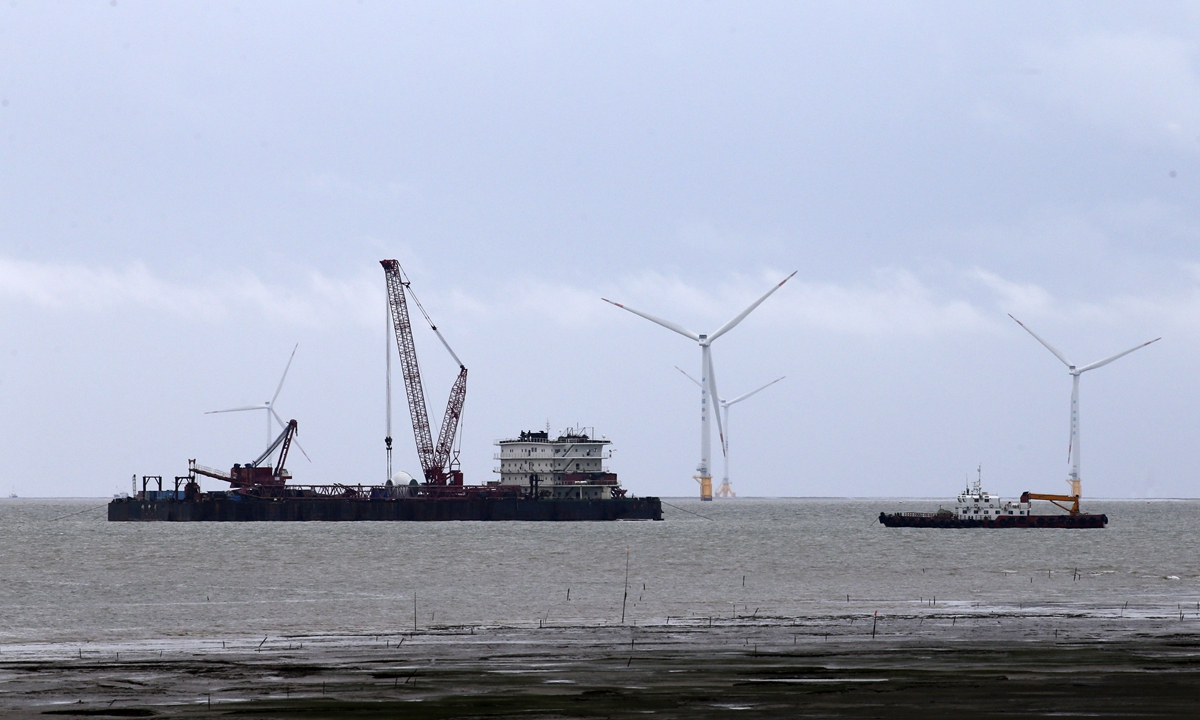Environmentalists call for action plans to meet China's carbon neutral pledge by 2060
By GT staff reporters Source: Global Times Published: 2020/9/24 1:32:53

An offshore wind farm in Nantong, East China’s Jiangsu Province is seen under construction. The wind farm, with a total investment of 14.3 billion yuan ($2.09 billion), will be able to meet the annual electricity consumption of about 990,000 households. Photo: cnsphoto
China's bold pledge to be carbon neutral by 2060, a goal far exceeding any climate action by the US, will see the country focus on renewables and revolve its economy around green growth, say Chinese environmentalists who are urging action plans to be set for low-carbon growth over the coming decades to reach a net zero carbon footprint.
China aims to have CO2 emissions peak before 2030 and achieve carbon neutrality before 2060, Chinese President Xi Jinping said Tuesday at the general debate of the 75th session of the UN General Assembly via video, according to the Xinhua News Agency.
"China will scale up its Intended Nationally Determined Contributions by adopting more vigorous policies and measures," he said.
This is the first time China has set a long-term goal for carbon emissions, which is expected to strengthen the global response to climate change that has been crippled by the US' withdrawal from the Paris climate accord and the COVID-19 pandemic, Ma Jun, director of the Institute of Public and Environmental Affairs, told the Global Times on Wednesday.
The 2060 goal will "lead hesitant or reluctant countries and regions to reduce carbon emissions by following in China's footsteps," Ma said.
China is an active partner in global climate governance, Foreign Ministry Spokesman Wang Wenbin told a regular press conference on Wednesday.
Non-fossil fuel now makes up nearly 15 percent in the nation's total energy consumption. China has 30 percent of the world's installed capacity of renewable energy, representing 44 percent of the world's growth. More than half of the world's new energy vehicles are in China and the nation has contributed 25 percent of the world's increasing in afforestation areas since 2000, Wang said.
The US, the world's largest cumulative emitter of greenhouse gases, "has rejected binding quantified emissions reduction targets and refused to take even minimal steps to protect the planet," the spokesman said, noting that the US is substantially holding back global emissions reductions and low-carbon development.
For China's carbon neutrality pledge to be honored, the nation needs to focus more on solar and wind energy which are almost 100 percent green, Ma said.
Ma is expecting more research and development commitments to make renewables, including hydrogen energy, readily available, but the environmental consultant is also hoping for advances in carbon capture and storage, a technology enabling reduced emissions from burning fossil fuels, whose feasibility remains in doubt.
While the road map to ensuring the nation's net zero carbon emissions is subject to technology advances, it's important for the country to lay out urgent action plans to steer the economy toward that goal, environmentalists stressed.
"It makes sense for the government to draw up plans in phases - breaking down the long-term pledge into smaller goals to be achieved, say, on a five-year basis - and to fit different parts of the country into differentiated action plans, Ma said.
In a research report sent to the Global Times on Wednesday, UBS economists "expect China to set a higher standard of environmental protection and pollution emission" in the 14th Five-Year Plan (2021-25), including setting non-fossil energy's share of total energy consumption to 18 percent, up from a target of 15 percent set for 2020.
The economists also environed a "further reduction of energy use per unit of GDP and CO2 and SO2 emissions." Demand for equipment, services and investment are estimated to continue to grow at a faster pace, the research report said.
By mapping out actions to be taken now, the nation will avoid a misleading and non-discretionary approach to implementing the pledge, Lin Boqiang, director of the China Center for Energy Economics Research at Xiamen University, told the Global Times on Wednesday.
The goal actually allows for flexibility in economic terms to reduce greenhouse gas emissions, according to Lin, explaining that emissions can be neutralized by efforts such as planting trees.
Different regions could design their plans for action that are in accordance with local economies, meaning emissions from certain sectors could be neutralized by other green growth-enabled businesses.
Other than the government's leading role in pushing the economy toward the goal, it's also important for the business community and citizens to play their part in fostering low-carbon growth, Ma said.
He cited Chinese tech giant Huawei's push to reduce emissions through the creation of green supply chains.
Global stock markets index provider MSCI unveiled two climate change indexes for China in mid-August to gauge the country's transition to a low-carbon economy.
The indexes are intended to improve listed companies' environmental, social and governance stewardship.
Posted in: ENERGY,INDUSTRIES